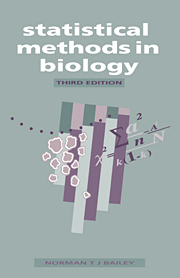Book contents
- Frontmatter
- Contents
- Preface
- 1 Introduction
- 2 Variability and frequency distributions
- 3 Estimation, standard errors and confidence limits
- 4 The basic idea of a significance test
- 5 Simple significance tests based on the normal distribution
- 6 The use of t-tests for small samples
- 7 Contingency tables and χ2
- 8 χ2-tests of goodness-of-fit and homogeneity
- 9 The correlation of measurements
- 10 Regression analysis
- 11 Simple experimental design and the analysis of variance
- 12 Introduction to factorial experiments
- 13 Random samples and random numbers
- 14 Partial correlation and multiple regression
- 15 Non-parametric and distribution-free tests
- 16 Notes on numerical calculation, calculators and computers
- Suggestions for more advanced reading
- Summary of statistical formulae
- Appendix tables
- Index
15 - Non-parametric and distribution-free tests
Published online by Cambridge University Press: 05 June 2012
- Frontmatter
- Contents
- Preface
- 1 Introduction
- 2 Variability and frequency distributions
- 3 Estimation, standard errors and confidence limits
- 4 The basic idea of a significance test
- 5 Simple significance tests based on the normal distribution
- 6 The use of t-tests for small samples
- 7 Contingency tables and χ2
- 8 χ2-tests of goodness-of-fit and homogeneity
- 9 The correlation of measurements
- 10 Regression analysis
- 11 Simple experimental design and the analysis of variance
- 12 Introduction to factorial experiments
- 13 Random samples and random numbers
- 14 Partial correlation and multiple regression
- 15 Non-parametric and distribution-free tests
- 16 Notes on numerical calculation, calculators and computers
- Suggestions for more advanced reading
- Summary of statistical formulae
- Appendix tables
- Index
Summary
INTRODUCTION
In most of the preceding discussions, which involved the performance of significance tests or the estimation of parameters such as means, standard deviations or correlation coefficients, an essential part of the undertaking was to start by making assumptions about the statistical distributions underlying the observations. Thus, the distribution of stature in Table 1 could be assumed to be, at least approximately, Gaussian or ‘normal’. Albinotic children in marriages between heterozygous partners would be expected to show a binomial distribution, as in Table 2. In Table 3 the Poisson distribution is used to describe the variable presentation of yeast cells in a haemocytometer. Later on, in discussing the correlation exhibited by pairs of measurements, as in Table 14, the more sophisticated notion of a bivariate normal distribution was introduced.
Of course, we do not expect all these theoretical distributions to be exactly reproduced in nature. We simply hope that in any specific situation we can choose a suitable and convenient distribution that is sufficiently accurate for practical purposes. The more sophisticated the theoretical concepts, the more trouble we shall have in justifying their practical application. Thus, in section 9.4, special consideration was given to the question whether a bivariate normal distribution for paired measurements could really be acceptable as a basis for correlational studies. The problem became even more acute when there were three or more factors, with partial correlation coefficients being introduced and the necessity of appealing to the notion of a multivariate normal distribution.
Information
- Type
- Chapter
- Information
- Statistical Methods in Biology , pp. 172 - 189Publisher: Cambridge University PressPrint publication year: 1995
